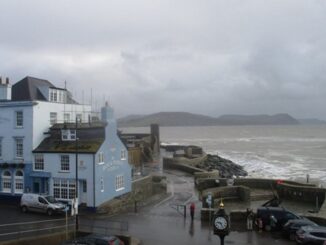
It takes a week to cycle from Penzance to Berwick. It took me 40 years. Because on the way, I wanted to include every town in England, in what amounted to some two years of day-rides. Most of these rides were point-to-point, but some were loops, and some looked on the map like a dropped noodle. It wasn’t a continuous line, but many separate lines, and all rides included towns I had not visited before. I used trains to get to starting points. Each ride had to be at least 20 miles, and in each new town, I had to touch a central feature, ideally the market cross or town hall. This is just one of hundreds of rides on this lifetime’s journey. A few more journey writeups can be found at my “Riding the Shires” website, from which this was taken, at Riding the Shires. Half a century of cycle-touring.
May 2024: A good few stations in England bear the euphemistic name Parkway, meaning “we couldn’t get the line into the town centre so the station is in the middle of nowhere.” None, I think, stretches the concept so close to breaking point as Tiverton in south Devon. Tiverton Parkway is fully six miles east of Tiverton. If you’re on foot, that’s a two-hour hike. If you’re on a bike, it’s an hour of riding, at least at my pace. There are in fact whole railway lines that are shorter than the gap between Tiverton and Tiverton Parkway. And if you have failed to look closely at the map and spot this extra mileage, it means your tight schedule for cycling to Lynton by nightfall has just got tighter. “Cripes,” I thought, alighting at Tiverton’s distant glorified bike shed of a station (Parkways are always glorified bike sheds). “It’s going to be a long day.”
I’d at least have the light, for it was late May. This should have been the flowering of spring into summer, but it was one more of those oh-so-English nothing days, mostly dry but mostly overcast. Worse, I had a headwind, for I’d picked the one day in 30 when the West Country gets northerlies. But at least it was only a breeze.
Had I not been under time pressure, I’d have done what every properly organised cyclist getting off at Tiverton Parkway does, which is use the Grand Western Canal towpath into Tiverton town. But this meandering route is even longer, considerably so, so I began this northbound ride across Devon and west Somerset on the busy, narrow and not very pleasant A373. I wished I’d been able to use the canal, for it is an interesting one, part of an early and only partially successful effort to link Bristol and Exeter by water and so spare merchant vessels the dangerous rounding of the Cornish coast. (The first bit of it, the Exeter Canal alongside the Exe, is considered the earliest canal in England, though this is disputed by those who hold that a true canal should be independent of any river).
Tiverton sounds like a brother town to the next stop down the line Totnes, but in fact they’re quite different, as industrial Crewe is from its posh neighbour Nantwich. Totnes with its quaint castle and fancy restaurants is a bastion of Waitrose progressives, but “Tivvy” is working-class Devon, and, though it too has a castle, its most striking building is an old textile mill. Its centre looked scruffy and faded, with too much ugly postwar infill, and its eateries had names like Elsie May’s or The Crusty Cob instead of Delphini’s Gelato or Zappa’s or other such Totnes ponciness. At one of them, I bought a big, meaty, though not very tasty, pasty, and ate it on the pavement before setting off. At five quid, it was a full meal in itself, which was just as well as I suspected it would have to do for the whole day.
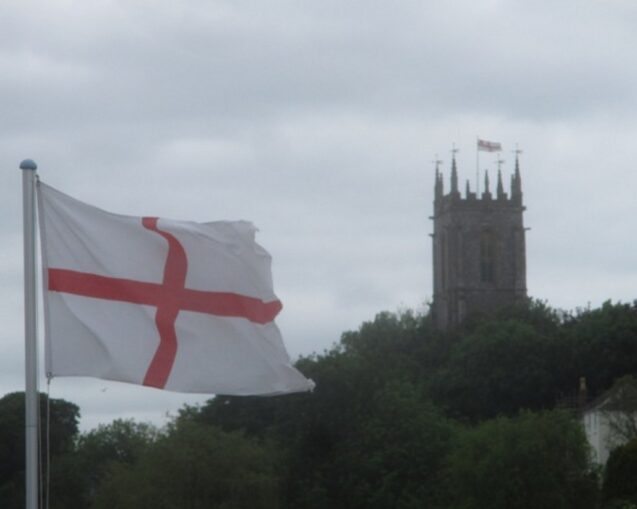
Tiverton
Descending from Tiverton the ancient market town, I crossed the Exe into Tiverton the factory town, with its terraces, canal and abovementioned mill, originally built by the inventor of “Bobbinet” lace-making machinery, John Heathcote. Heathcote was a Derbyshire entrepreneur who moved his operations down to Devon to escape Luddites and resentful local rivals, and make a fresh start in more welcoming hills. A whole little town grew up around his works. The company still bears his name, and now makes firemen’s gear and such like. It was weird finding this slice of the industrial north among the West Country farms and hamlets.
The northward road out of Tiverton had a sign that said “Longdrag Hill,” which I took as an omen. Scouring the one-inch map for valley lanes and ridge roads, I spotted a long byway between Tiverton and the next town of Bampton, running along the left bank of the Exe. That would do.
It proved to be a narrow, high-hedged lane that zigzagged, darted, bucked and plunged like a hunted hare. It leapt over streams and flitted along glade edges, never relaxing or keeping a straight line for long. Junctions were often without signposts or “give way” marks, so I had little idea of which branch to take, as this kind of road defeats even the one-inch map, and navigated crudely by keeping the Exe in sight on my right. It was fun, but by Cove, I’d had enough and crossed the river to join the busy A-road on the other side of the river, which ushered me in smart order round a bend in the river into Bampton.
This was a town I’d ridden through before, my diaries told me. But it was 40 years before, on one of my very first long-distance rides, and I had no memory of it at all beyond what I wrote at the time, “a pleasant town nestling in the hills,” a description which covers over 80% of inland towns in the West Country. So let me try to be a bit more fulsome here. Bampton was a loose cluster of whitewashed and bare stone cottages and shops grouped around a meeting of three roads, with a stone bridge crossing the River Batherm and a homely church tower rising from its centre. Noted for, a quick Internet search revealed, an old Exmoor pony market. It offered a cosy vista of gables and slate roofs from the hills surrounding it, one of which I now tackled as I moved on.
I could have recycled much of that description for the next town, Dulverton, except that it was slightly prettier and knew it. It had a proper market square, today serving as a de facto car park, and also a tourist drawcard as the southern gateway to Exmoor. It was bustling little town of outdoor, antique and gift shops, with a surviving leat running through as a reminder of its past in the wool trade. A leat was a channel drawn off a steeply-falling river to create a waterfall to power a mill wheel; Exeter has another example.
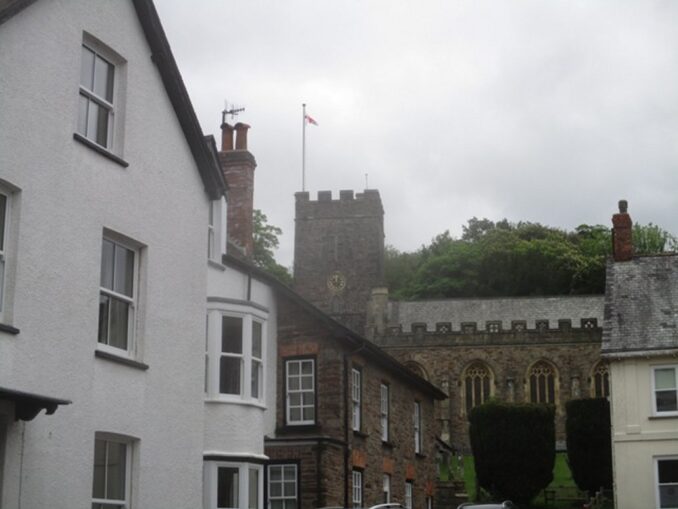
Dulverton
I’d been to Exmoor before, also decades before, but remembered this better. What I’d forgotten is just how high it is. The first leg of what was to prove a nearly six-mile ascent — the longest I’d tackled since crossing the Taebaek mountains in South Korea — was deceptively gentle, a very quiet B-road that snaked alongside the river Barle through a wooded valley. Here you began to notice for the first time the vivid green sheeting of moss that is such a feature of tree trunks, banks and walls in these parts. Even after later consulting the esteemed pages of the British Bryological Society, with its Bryophyte of the Month feature, I’ve no idea why there’s so much of it in Devon. (But I did learn two new words from that search).
And then the road gradually eased itself away from the river and began to climb through the dank, boulder-strewn woods. After a mile or two, I reached a hamlet or farm called Higher Combe. A steeper mile or so further on was the moor line; the woods fell away abruptly and I was adrift in a sea of heather and gorse. The gradient eased slightly now, but still continued to rise, with dips, to Winsford Hill. Only at this summit did I finally reach a short, uneven stretch of plateau, and was able to get back into the saddle. It had taken nearly two hours to get up here, and in doing so, I’d effectively completed a four-mile hike.
As moors go, I found Exmoor less barren and desolate than the High Peak I was familiar with. Green was the base colour on the tops here, with the heather merely adding purple streaks and blotches. Exmoor is too small to give you the feeling of being truly cut off from the world that you get on Kinder Scout; up here, the distant surrounding hills are always visible. Being a mixed bag geologically, it also lacked the elemental bleakness of the granite dome of Dartmoor.
I like to natter with people on my rides, but I hadn’t exchanged a word with anyone since the pasty purchase at Tiverton. The one little chat I did have this day now came at Withypool crossroads, where I chanced upon, of all things, a council painter touching up a quite complex middle-of-nowhere signpost with five arms.
Now I’m a sucker for rural signposts, as they make such excellent foreground subjects for landscape photographs, and have snapped dozens of them all over the country (in fact, I’ve wondered if I shouldn’t buy a fancy camera and build a coffee-table book around rural signposts). My favourite type is the simple black-on-white lettered arm, with a roundel (ring shape) on top naming the county. In the West Country, the signpost will often have its own name as well, written onto the shaft, as here: Comer’s Cross. This painter said that these traditional-style rural signposts mostly date from the 1950s (and not, as I liked to imagine, from the days of Jude the Obscure wandering about Wessex). Older specimens were quite rare, as most were ripped up in World War II to confuse any German paratroopers who might waft down of a night, and after the war they were mislaid or not reinstated. He added, heresy upon heresy, that some of the arms are now made of plastic, as opposed to the good old cast iron of old.
“Two of the five arms here are plastic,” he said. “Can you tell which?”
“No.”
“Ah, but you can when you paint them.”

On Exmoor
And so down to Exford, which sits in a long valley running through the middle of Exmoor like the groove of a coffee bean. Near Exford, which I didn’t actually enter, I joined the B3223, the only easy road of the ride. Despite its “B” status, I had it more or less to myself and a couple of Waitrose delivery vans. It took me along the floor of the now vanished Exmoor Forest, past sheep pastures, craft shops, B&B farms, campsites and a finger-post to a place called Pickedstones, which only lack of time stopped me from making a diversion for.
There wasn’t so much as a hamlet until Simonsbath, which looked like a cluster of upmarket hotels and guesthouses grouped around a bridge over my old friend the Barle, which I’d last passed at the foot of the moor. Here flew the day’s fourth Ukrainian flag — nowhere in England were the tribulations of remote Slavic steppe-dwellers more keenly felt than in West Country villages with stone cottages worth half-a-million.
By Simonsbath, I was running an hour late, which was actually an achievement, as I normally expect to miss arrival deadlines by at least two hours. That one hour mattered. Dusk was coming on now but I still had to tackle the western summit of Exmoor before dropping down to the coast. Even with good lights, I wasn’t keen to cross a moor, even one as tame as this, in the dark.
The day’s third climb, or rather hike, lifted me out of Simonsbath and up onto Brendon moor. Here, the wayside moss was so dense it seemed to ooze over the drystone walling like green slime from a cheap horror film. This road too was empty apart from the host of sheep that blithely wandered across it without so much as a ditch or verge bank to deter them; I nearly hit one myself and couldn’t imagine how many get killed at night. But the view, which now included the sun sinking behind thin cloud over the Bristol Channel, was breathtaking.
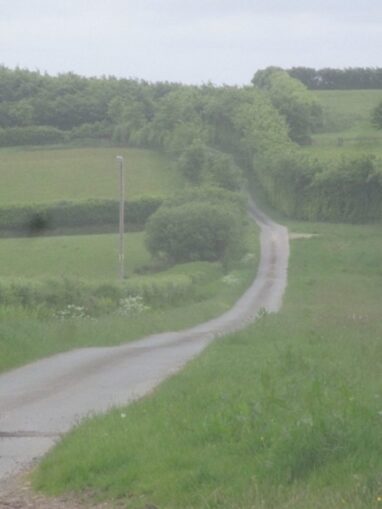
On Exmoor

Lynton was just off the northern side of the moor, but I could see from the map that the approach might be complicated due to the bewildering topography of the coast here. As the crow flies, I was just over three miles from the town when I began the descent off the moor. But it took 90 minutes and two more steep climbs to get there, as the road had to negotiate two of three deep wooded gorges — “cleaves,” the map called them — that converge around the little town. At times during this blind, directionless scramble in the gloom, it felt like trying to crawl back up one of those crazy slides in theme parks.
The hotel, though, was a nice surprise. At the time of booking, I’d been unable to read anything into the poetic name, Valley of Rocks, and had assumed from the low price, £47, that it was one more backstreet B&B with a pretentious name.
But no. Standing proudly in the middle of Lynton, the Valley of Rocks was probably the best hotel in town, and surely had the most interesting interior. You stepped through a revolving door into a fine lobby, and raised your eyes to first and second floor arcaded galleries peopled with black and white painted silhouettes of smart guests from the 1930s, all making gestures of welcome. A cheap but most effective trick, which didn’t in fact cheapen the rest of the establishment, but set its tone. It was the kind of lobby where you imagined Hercules Poirot gathering everybody for the denouement. Other features were good fireplaces, nicely detailed railings and arched colonnades with wrought-iron spandrels — I’ve waited decades to use that word — and a staircase that made you feel like you were coming down to pick up an Oscar.
The modern hotel dates from the late 1800s. It had, I gathered, been a good deal more extravagant in its heyday, epitomising a fad on this coast with things Alpine, and once sported a Tyrolean tower. It was the first hotel I think I’ve ever stayed in that had had a smoking room (now repurposed). Nearly next door, the mock Tudor-Swiss town hall, with its showy bargeboards and balcony balustrades, continued the theme.

Lynton hotel

Delighted with the hotel — heaven knows how I ended up paying so little for this — I wasn’t so happy with Lynton. Having eaten nothing substantial since the Tiverton pasty, and conquered Exmoor on an empty belly, I was surprised and miffed to find that this celebrated resort of the rich, arty and fashionable had no shops that stayed open after seven. I wasn’t in the mood for a posh restaurant with candles and simpering waiters. So I decided to tough it out till the buffet breakfast next morning and survive until then on alcoholic beverages.
Lynton was eerily quiet in the long May evening. No traffic, no gulls cawing, no radios, no doors or windows shutting or other sounds of daily life in a seaside town. I couldn’t even hear the sea, which slumbered far below the church and cemetery overlooking it. All I could pick up was the faint drone of two teenaged girls sitting on a veranda across the road declining the new verb wuzlike – “.. so I wuzlike .. and ’e wuzlike .. and I wuzlike .. oh my God! .. and they wuzlike .. ” It was a long time since I’d enjoyed a serenity as deep as this in the main street of an English town.
Another great thing about the hotel was that my room had a bath. This wasn’t just a matter of self-indulgence. Coming out of Simonsbath, I’d felt the first in twinges of cramp, a problem that has grown worse with age and which is particularly bad after hours of hill-climbing. I hadn’t abused my calf and thigh muscles like this for years, and I knew they were going to let me have it at about three in the morning. These attacks were proper groan-aloud-and-writhe-in-agony sessions that went on for fifteen minutes or more.
But there was a cure — lounging in a hot bath for 30 minutes before bed, preferably with a few vodkas, to get the warmth deep into the muscles and relax them. This was usually enough to dull the pain and halve the duration, and so it was in Lynton. The wee-hours attack, when it came, was mild. I got off lightly. (Part 2 to follow)
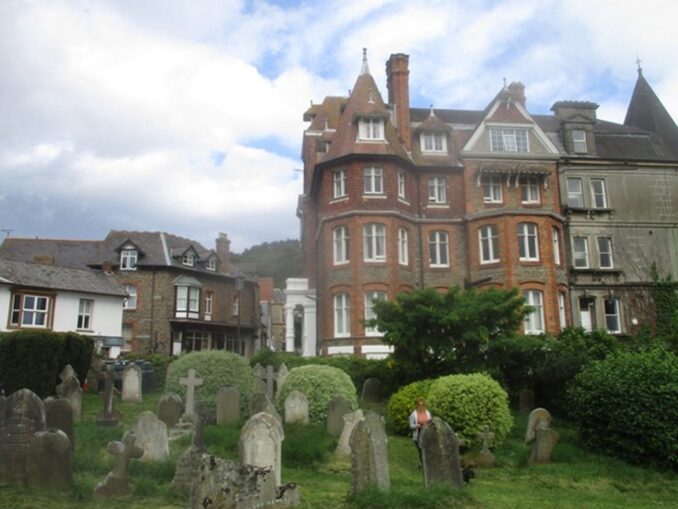
Lynton
More like this can be found at my website Riding the Shires. Half a century of cycle-touring.
I’m fine with being quoted (up to two paragraphs), but all rights @joeslater.
© text & images Joe Slater 2025

